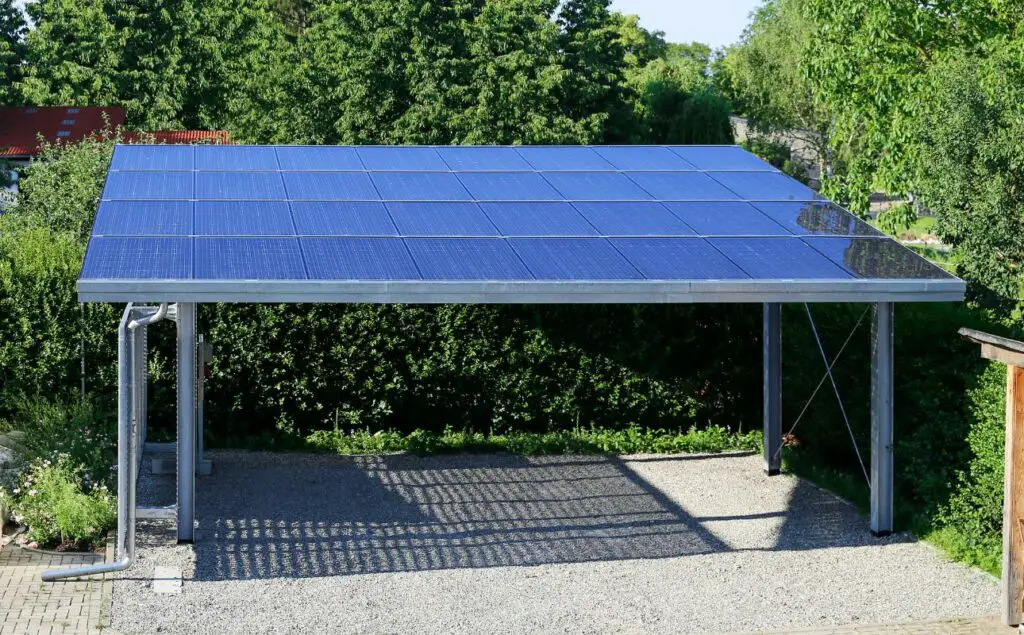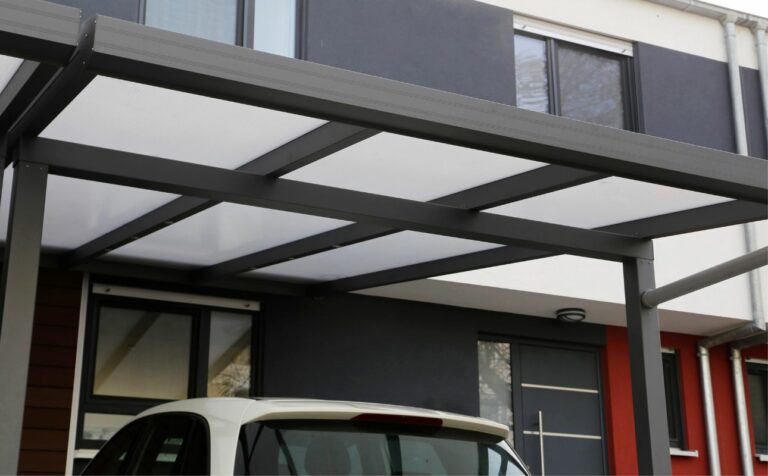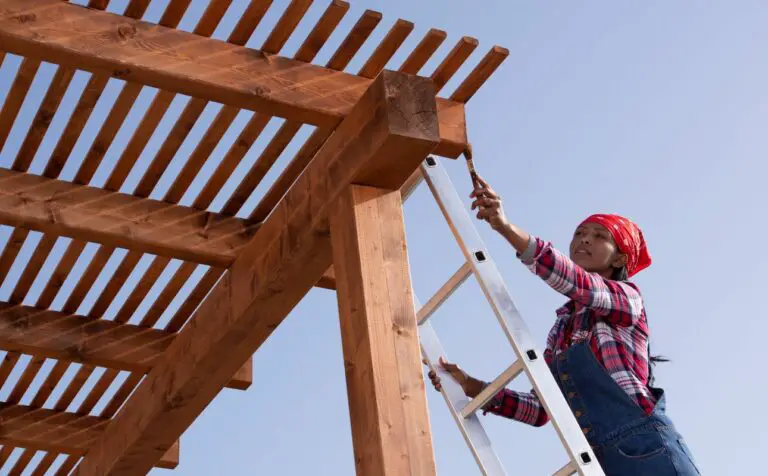As homeowners look for ways to protect their vehicles from the elements, carports have become an increasingly popular choice. If you live near power lines, you may be wondering if it is safe to install a carport under them.
While it is possible to do so, there are several important factors to consider before proceeding. Installing a carport under power lines can pose significant risks, including electrical shock and fire hazards. As such, it is essential that homeowners take steps to mitigate these risks and ensure that their carport is installed safely and securely.
In this article, we will explore the key considerations involved in installing a carport under power lines and provide guidance on how to do so safely and effectively.

Risks of Installing a Carport Under Power Lines
The installation of a carport near overhead power lines poses potential hazards that need to be carefully considered. It is important to note that power lines carry extremely high voltage electricity, which can cause serious injury or even death if someone comes into contact with them.
Installing a carport too close to the power lines may violate local laws and regulations, resulting in legal liabilities for property owners. Before deciding on installing a carport under or near overhead power lines, it is essential to take into account safety concerns and legal requirements.
One key factor to consider is the height of the power lines; it is crucial to ensure that the height of the carport does not pose any risk of contact with the power lines.
Consider the Height of the Power Lines
Taking into account the height of nearby overhead power lines is crucial when constructing any structure that could potentially come into contact with them, as potential hazards can arise if proper precautions are not taken.
When considering a carport installation under power lines, it is important to understand clearance requirements and ensure that the structure does not violate any local codes or regulations.
Here are four specific items to consider when assessing the height of power lines in relation to a carport installation:
- Determine the minimum clearance required by law between your carport and the power line;
- Measure the height of your proposed carport structure, taking into account any sloping terrain that may impact clearance;
- Consider future growth of surrounding foliage or trees, will they encroach upon the required clearance over time?;
- Take note of weather patterns in your area, as storms or high winds could cause branches or debris to fall onto your carport if it’s located too close to a power line.
Measure the Distance Between the Carport and Power Lines
To ensure compliance with local codes and regulations, it is important to accurately measure the distance between a proposed carport installation and nearby overhead power lines.
Safety precautions must be taken when determining the placement of a carport in relation to power lines to avoid potential electrical hazards. Legal requirements may also dictate minimum distances that must be maintained between structures and power lines.
It is recommended to consult with local authorities or utility companies for specific guidelines regarding placement of carports near power lines. Accurate measurements can help prevent accidents and ensure compliance with legal requirements, providing peace of mind for homeowners.
Choose the Right Materials for Your Carport
Selecting appropriate materials for a carport is crucial to guaranteeing its resilience and longevity, similar to how choosing the right ingredients in a recipe is essential for creating a delicious meal.
Cost-effective materials such as wood or steel are commonly used for carports due to their durability and affordability. Eco-friendly options such as aluminum or polycarbonate can also be considered for those who prioritize sustainability.
It is important to choose materials that are resistant to rust, corrosion, and weather damage since carports are often exposed to outdoor elements. Careful consideration of material choices ensures that the carport will remain sturdy and functional over time.
Install Proper Grounding and Bonding
Hire an Electrician to install proper grounding and bonding in your home or building.
An electrician can ensure that the electrical system is safe and up-to-code. Following local building codes is important as it ensures safety standards are met and prevents costly legal issues.
Hire an Electrician
The installation of any structure within close proximity to overhead electrical lines requires the expertise of a qualified electrician to ensure that safety measures are taken to prevent potential hazards.
When considering installing a carport under power lines, it is crucial that you hire an experienced electrician who can evaluate the site and provide guidance on the best course of action.
The electrician will assess factors such as clearance requirements, wiring location, grounding and bonding needs, and load capacity to ensure that your carport does not pose a risk to people or property.
Follow Local Building Codes
Adhering to local building codes is imperative when considering the installation of any structure in close proximity to overhead electrical lines. Understanding local regulations and potential legal implications can ensure that your carport will not cause harm or pose a risk to nearby power lines.
These codes are in place to safeguard individuals, property, and the surrounding environment from hazards that may arise due to poor construction or maintenance practices. It is important to follow these guidelines as they help ensure that your carport is safe and secure for use.
Navigating through these regulations on your own can be difficult, especially if you do not have prior knowledge of building codes. As such, it is recommended that you consult with professionals who are well-versed in this aspect of construction before proceeding with any installation plans.
Hire a Professional for Installation
- Ensure Proper Installation and Safety Measures: Prior to the installation of a carport, it is crucial to hire a professional who can ensure proper installation and safety measures are in place. This includes conducting thorough site inspections, adhering to building codes and regulations, and utilizing appropriate tools and equipment for the job.
- Obtain Necessary Permits: In some regions, obtaining necessary permits may be required before installing a carport. A professional installer can assist with this process by submitting permit applications on behalf of the client and ensuring all requirements are met.
- Overall Importance: Hiring a professional for carport installation not only ensures safe construction but also eliminates potential legal issues that may arise from improper installations or lack of permits. It is best to prioritize hiring professionals with experience in such projects rather than attempting DIY installations.
Ensure Proper Installation and Safety Measures
Proper installation and safety measures are imperative when considering the potential hazards associated with constructing a structure in close proximity to overhead electrical transmission infrastructure.
Regular maintenance should be performed to ensure the integrity of the structure remains intact. There may also be potential legal issues if proper safety measures are not taken during installation.
Obtain Necessary Permits
To ensure proper installation and safety measures, it is imperative to obtain necessary permits before building a carport under power lines.
The permit application process involves submitting plans for approval and obtaining the necessary permits from local authorities. Permit fees and requirements vary by location, so it is important to research and comply with all regulations.
Failure to obtain the necessary permits can result in fines, legal action, or even having to remove the carport altogether.
Regularly Inspect and Maintain Your Carport
Regular inspection and maintenance of a carport is essential to ensure its longevity and safety, as it can help identify potential issues that may arise from being situated near power lines.
Carport maintenance involves checking for any damages or signs of wear and tear, such as rust, cracks, or loose bolts. It is also important to check the stability of the carport structure regularly to ensure that it can withstand strong winds or heavy snow loads.
Safety precautions must be observed when inspecting and maintaining a carport under power lines. The use of appropriate personal protective equipment (PPE) such as gloves and safety glasses is crucial to prevent any accidents from happening. Proper grounding measures must be in place to avoid electrical hazards caused by contact with power lines.
The Bottom Line
Installing a carport under power lines is possible, but it requires careful consideration and appropriate safety measures. The risks involved in this type of installation should not be taken lightly, as any mistake could result in serious injury or damage to property.
To ensure the safety of your family and property, it is important to measure the distance between the carport and power lines accurately, choose the right materials for your carport, install proper grounding and bonding, and hire a professional for installation.
Remember that safety should always come first when working around electricity, parallelism makes it clear that every step is equally important when dealing with such dangerous situations.





